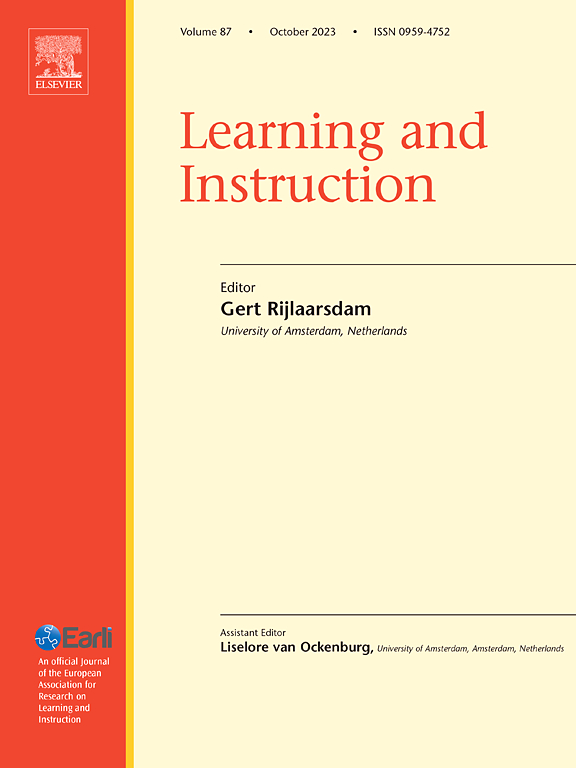Mother, Father, and Toddler Spatial Language in English and Spanish during Play: Associations with Toddlers’ Emerging Spatial Cognition
IF 4.9
1区 教育学
Q1 EDUCATION & EDUCATIONAL RESEARCH
引用次数: 0
Abstract
Background
Parents' spatial language predicts children's spatial language and cognition. Most research focuses on mothers, leaving unknown how fathers' spatial language relates to children's spatial learning. Furthermore, most studies of spatial language involve English-speaking samples, precluding an understanding of common and unique ways that parents and toddlers from different language communities use spatial language during play.
Aims
We videorecorded English- and Spanish-speaking fathers, mothers, and toddlers during a spatial activity and tested associations between their use of spatial language and toddlers’ understanding of shape names and spatial relations.
Sample
Participants were 56 mothers, 44 fathers, and 58 toddlers (ages 24–36 months; 30 female). For 42 families, both mother and father participated. For 14 families only the mother participated, and for 2 families only the father participated.
Methods
Mother-toddler and father-toddler dyads interacted with a magnet board. Interactions were transcribed and coded for spatial language. Fifty-five dyads used all or mostly Spanish spatial language, and 42 used all or mostly English. A researcher assessed toddlers’ understanding of shape names and spatial relations.
Results
There were no differences in spatial language between mother-toddler and father-toddler dyads. English-speaking participants used a greater variety of spatial words/phrases than Spanish-speaking participants, which may reflect language differences how spatial concepts are encoded. Parents' spatial talk related to toddlers' spatial talk, and parents' and toddlers' spatial talk related to toddlers’ spatial skills.
Conclusions
Meaningful individual differences in spatial language emerge by toddlerhood, and both fathers and mothers contribute to toddlers’ production and understanding of spatial words.
游戏中英语和西班牙语的母亲、父亲和幼儿空间语言:与幼儿空间认知的关系
背景:父母的空间语言对儿童的空间语言和空间认知具有预测作用。大多数研究都集中在母亲身上,不知道父亲的空间语言与孩子的空间学习有什么关系。此外,大多数关于空间语言的研究都涉及以英语为母语的样本,这妨碍了对来自不同语言社区的父母和幼儿在游戏中使用空间语言的共同和独特方式的理解。目的我们在空间活动中录下说英语和西班牙语的父亲、母亲和幼儿,并测试他们对空间语言的使用与幼儿对形状名称和空间关系的理解之间的联系。样本参与者是56位母亲,44位父亲和58位幼儿(年龄24-36个月;30名女)。在42个家庭中,父母双方都参与了研究。14个家庭只有母亲参与,2个家庭只有父亲参与。方法母亲-幼儿和父亲-幼儿用磁铁板进行互动。相互作用被转录和编码为空间语言。55对夫妇全部或大部分使用西班牙语空间语言,42对夫妇全部或大部分使用英语。一名研究人员评估了幼儿对形状名称和空间关系的理解。结果两组幼儿空间语言差异无统计学意义。说英语的参与者比说西班牙语的参与者使用更多的空间词/短语,这可能反映了空间概念编码方式的语言差异。父母空间话语与幼儿空间话语相关,父母和幼儿空间话语与幼儿空间技能相关。结论幼儿空间语言出现显著的个体差异,父亲和母亲对幼儿空间词汇的产生和理解都有影响。
本文章由计算机程序翻译,如有差异,请以英文原文为准。
求助全文
约1分钟内获得全文
求助全文
来源期刊

Learning and Instruction
Multiple-
CiteScore
11.30
自引率
4.80%
发文量
109
期刊介绍:
As an international, multi-disciplinary, peer-refereed journal, Learning and Instruction provides a platform for the publication of the most advanced scientific research in the areas of learning, development, instruction and teaching. The journal welcomes original empirical investigations. The papers may represent a variety of theoretical perspectives and different methodological approaches. They may refer to any age level, from infants to adults and to a diversity of learning and instructional settings, from laboratory experiments to field studies. The major criteria in the review and the selection process concern the significance of the contribution to the area of learning and instruction, and the rigor of the study.
 求助内容:
求助内容: 应助结果提醒方式:
应助结果提醒方式:


